Great Retreat (Serbian)
The Great Retreat, also known in Serbian historiography as the Albanian Golgotha[4] (Serbian: Албанска голгота / Albanska golgota), was a strategic withdrawal of the Royal Serbian Army, that took place during the First World War. In late October 1915, Germany, Austria-Hungary and Bulgaria launched a synchronised major offensive against Serbia. That same month, France and Britain landed four divisions at Salonika, but were unable to move north to help their outnumbered ally caught between the invading forces. The Serbs slowly retreated southwards with the plan to withdrew into Macedonia to link up with Allies forces. After Bulgarian forces prevented a French advance in the Vardar Valley and the defection of Greece, the Serbs found themselves swept together in the plain of Kosovo by the converging Austro-Hungarian, German, and Bulgarian columns; few options remained to escape the invaders encirclement.[5]
| Great Retreat (Serbia) | |
|---|---|
| Part of Serbian Campaign (1915) Albanian Golgotha | |
 Serbian troops retreating through the mountains | |
| Type | Strategic withdrawal |
| Location | 42°22′56.69″N 19°58′51.29″E |
| Planned by | Serbian Army High Command |
| Commanded by | Field Marshal Radomir Putnik |
| Objective | Reaching the Adriatic coast |
| Date | 25 November 1915 – 18 January 1916 |
| Executed by | Royal Serbian Army (with civilian refugees and Austrian prisoners) |
| Outcome | Evacuation to Corfu |
| Casualties | Serbian soldiers[1]
Serbian civilians[2]
Habsburg pows[3]
|
On 23 November 1915, the government and the supreme command made the decision to retreat across the mountains of Montenegro and Albania where they hoped to reach the Adriatic coast and be rescued by Allied ships. The retreat took the remnants of the Serbian Army, the King, hundreds of thousands of civilian refugees, with thousands of Austrian prisoners, across some of the roughest terrains in Europe in the middle of winter, enduring harsh weather, treacherous roads, and enemy raids. Between November 1915 and January 1916, during the journey across the mountains, 77,455 soldiers and 160,000 civilians froze, starved to death, died of disease or were killed by enemies. The Austrians used the new technology of the time dropping bombs on the retreating columns in what has been called ‘the first aerial bombardment of civilians’.[6]
Out of the 400,000 people who set out on the journey, only 120,000 soldiers and 60,000 civilians reached the Adriatic coast to be evacuated by Allied ships to the island of Corfu where a Serbian government-in-exile headed by Prince-Regent Alexander and Nikola Pašić was established. 11,000 more Serbs would die later of disease, malnutrition, or exposure sustained on the retreat. In some sources published following the conflict, the event was described as the greatest and most tragic episode of the Great War.[7]
Background
Serbian campaign

On July 28, 1914, a month after the assassination of Austrian archduke Franz Ferdinand, Austria-Hungary, the second-largest country in Europe, declared war on Serbia. Five months later after suffering a third major defeat on the battlefield,[8] the ancient Habsburg Monarchy was left humiliated by "the peasant regiments of a small Balkan kingdom”. Franz Ferdinand had not been avenged, with the Dual Monarchy losing twice as many men as the Serbs had. The blow to Habsburg prestige was incalculable and Serbia marked the first Allied victory of World War One.[9][10]
In early 1915, the German chief of the general staff von Falkenhayn convinced the Austro-Hungarian chief of staff von Hoetzendorf to launch a new invasion of Serbia. In September Bulgaria signed a treaty of alliance with Germany and quickly mobilized its army. [11] On 6 October 1915, combined German and Austro-Hungarian forces under the command of Field Marshall August von Mackensen attacked Serbia from the north and west with the intention of drawing the bulk of the Serbian forces along the Sava and Danube.[12]
On 11 October, without any previous declaration of war, the Bulgarian started making attacks on Serbian border positions; then on 14 October Bulgaria finally declared war on Serbia, the First and Second Armies under the command of General Boyadzhiev, advanced into the Timok region of northeastern Serbia[13] with the mission of cutting the vital rail line that ran from Salonika, up the Vardar and Morava River valleys, and depriving Serbia of reinforcements and artillery ammunition.[14] Numbering nearly 300,000 men, the forces of Bulgaria quickly overwhelmed the weak Serbian units along the frontier.[13] The Serbian Army had 250,000 men of which a large number were already battling 300,000 Germans and Austrians in the north. In addition Austrian troops soon started marching from Dalmatia.[15]
Facing a front of 1,200 kilometres (750 mi) against three armies and as promises of aid and reinforcements from the Allies fell through, the Supreme Command of the Serbian Army started an organised retreat towards Kragujevac and Niš.[15] On 6 November the Bulgarian First Army, made contact with General Gallwitz’s Eleventh German Army in the vicinity of Niš, on 10 November they crossed the Morava River about 18 miles south of Niš and struck the Serbs. For two days, the greatly outnumbered Serbian army held Prokuplje but eventually had to retreat.[12]The pressure of the Austro-Hungarians, the Germans, and the Bulgarian First Army in the north and the Bulgarian Second Army advancing from the east forced the Serbs to retreat in a southwesterly direction into Kosovo.[16]
Prelude
Kosovo Polje

In mid-November, the Serbian armies reached Pristina ahead of their pursuers but were unable to break south through the blockade of the Bulgarian Second Army, at Kačanik Pass near Skopje, to reach Salonika and establish the liaison with the French troops of General Sarrail.[12]
The rupture of communications between Niš-Skopje-Salonika, and the rupture of the liaison with the Allies, brought the army into a most critical situation. Field Marshal Putnik begins concentrating his troops for the purpose of securing access to the plateau of Gnjilane known as the "Field of Blackbirds"; the region that resonated through five hundred years of Serbian history was the site of a famous battle in 1389 where the Serbs were defeated by the Turks, and later became the birthplace of Serbian nationalism.[3][16]
The entire Bulgarian army, supported from the north by parts of the Eleventh German Army, now advanced against the Serbs. Following intense fighting on 23 November Pristina and Mitrovica fell to the Central Powers, the Serbian government abandoned Prizren its last temporary capital in Serbia.[17]
Only three possibilities were considered: capitulation and separate peace, final honourable but desperate battle to annihilation, or further retreat. Nevertheless, only two options, retreat, and counter-attack were seriously considered, while the third one, capitulation, was not an option on the table; the Serbian government led by Prime Minister Nikola Pašić, Prince Regent Alexander and the Supreme Command under Field Marshall Radomir Putnik made the decision to order a general withdrawal and fight on from exile.[15]
The only possible avenue of escape lay to the southwest and northwest, over the towering Korab and Prokletije mountain ranges of Albania and Montenegro, part of the Dinaric Alps, a region of which the mean altitude is over 6,000 feet (1,800 m) as the snow began to fall. The Serbian Government planned to reorganise and reform the army with the help and support from the Allies.
On 23 November, Vojvoda Putnik ordered all Serbian forces to use the last of the artillery ammunition, then bury the cannon, taking breechblocks and sights with them; if burying the guns was impossible, they were to be rendered useless.[14]
On 25 November 1915, an official order of retreat addressed to the commanders of all armies, was published by the Serbian High Command:
The only way out of this grave situation is a retreat to the Adriatic coast. There our army will be reorganized, furnished with food, arms, munitions, clothing, and all other necessities which our allies will send us, and we shall again be a fact with which our allies must reckon. The nation has not lost its being, it will continue to exist even though on foreign soil, so long as the ruler, the government and the army are there, no matter what the strength of the army may be.[18]
— Serbian High Command
Retreat
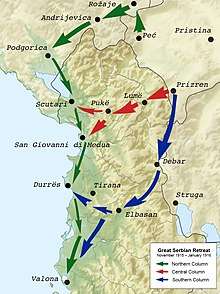
The Serbian Army split into three columns heading towards the mountains of Albania and Montenegro, pursued by the Austro-Hungarian Tenth Mountain Brigade and by the German Alpine Corps.[12]
The army’s rock-bottom morale was boosted by the presence of the ailing, 71-year-old King Peter, who had stepped aside on June 14 to let his son Prince Alexander rule as Regent but now resumed his throne to face the crisis with his people. The elderly monarch, who was almost blind, traveled through the mountains riding in an ox cart.[19]
In order to evade General Mackensen's final encirclement effort, the Serbian army, and a mass of civilians fleeing the massacres perpetrated by Austro-Hungarian troops,[20] retreated along three routes, all converged on Lake Scutari, and from there reached the Adriatic.[21]
- The Northern Column, took the route across southern Montenegro, from Peć to Scutari, via Rožaje, Andrijevica and Podgorica.[22] [23]
The group was composed of the First, Second and Third Army and the troops of the defense of Belgrade, it contained the largest contingent of Serbian troops, it also included a mobile medical unit named "The first Serbian-English Field Hospital", with two doctors, six nurses and six ambulance drivers, the unit was headed by British nurse and commissioned major, Mabel Stobart.[24] The retreat of this force to Andrijevica was to take place under the direction of the First Army, which, with this object, was to occupy positions at Rožaje. The mission of the troops of the defense of Belgrade was to cover the retreat of the Army of the Timok as long as that army had not begun its movement of retreat, and then to retire in its turn,[7] because of that the northern column delayed its departure from Peć until 7 December. It also had the responsibility to act as a rearguard against an attack by the Austro-Hungarians, Bulgarians, and Germans. Tracing an arc from northwest to southwest through Montenegrin territory and skirting the northern border of Albania, in the snow-covered mountains, hunger, exposure, and disease killed soldiers and civilians, as well as prisoners of war traveling with them, by the thousands.[25]
Serbian officers and artillery crews in Montenegro handed over 30 cannons to the Montenegrin Army,[14] Montenegrin forces played a key role in covering up the withdrawal, most notably against Austro-Hungarian forces in the Battle of Mojkovac.[26] The northern column began to reach Scutari on 15 December.
- The Central Column took the route through central Kosovo across northern Albania, from Prizren to Scutari via Lum and Pukë.[27]
The central column consisted of the King, the Crown Prince, the administration and the Supreme Command of the Army. Once across the Vizier's Bridge, the troops, who had retreated from Macedonia, would continue west, through Albania, ultimately to Alessio. The Timok Division would also continue to move south and then west through Albania to Durrës. It had the shortest route to the sea but encountered some resistance from hostile Albanians.[28]
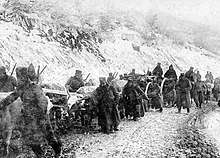
The retreat of the Serbian army was attacked by Kosovo Albanians, they harassed the columns of soldiers by mounting guerrilla actions to pick off weak detachments.[29][30] Albanians attacked the Serbian army during the retreat as revenge for their incorporation into Serbia and repression they experienced from Serbian authorities during the Balkan Wars.[29][30] In Albania, Albanian irregulars sought revenge for the severe treatment of Muslim soldiers by the Serbian side during the Balkan Wars and Serb troops were at times attacked by snipers.[31][32][33] This all was in the context of the wider modern Serb-Albanian conflict that started in 1878.[29][30] [29][34] The only safe area of passage was that in Durrës and its hinterland, which were under the control of Essad Pasha Toptani, an Albanian leader and former Ottoman General, who as part of his alliance with Serbia, provided protection to the Serbian army.[35][36]
Regent Alexander crossed it in just two and a half days, the Serbian government set off on 24 November 15 and reached Scutari four days later, while the officers of the Supreme Command who accompanied the Chief of the General Staff Radomir Putnik took longer, leaving on 26 November and arriving in Scutari on 6 December.[26]
- The Southern Column was sent in the third route of withdrawal, from Prizren to Lum and further through the Albanian mountains to Debar and Struga.[37]
The southern column was the first to depart and the last to arrive at the coast. The southern route presented the most direct way to make contact with Sarrail’s Army of the Orient. The General Headquarters had asked the commanders of these groups to keep in constant telegraphic communication, but from the first day of the operations, this was found to be impossible. The geography of the country did not allow of any other means of communication, so that the commanders of these groups were, during the whole movement, left to their own devices.
All the troops part of this group were placed under the orders of the commander of the Army of the Timok.[7] The column left on 25 November and moved south all the way to Elbasan. Along the way it had to contend with Albanian resistance and Bulgarian attacks; on 10 December, the Bulgarians attacked Serbian positions along the crest of the Jablanica mountain range.[38] As the Bulgarians again reached Struga before them, Serbian soldiers and civilians turned southwesterly, marching down the Albanian coast to Valona and across via Tirana reaching Durrës on 21 December.
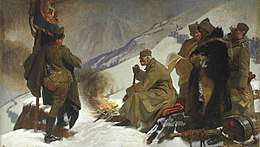
As early as 20 November, Pašić had sent an urgent message to Serbia’s allies, asking for supplies, particularly food, to be sent to the Adriatic ports, but when the Northern and Central columns arrived in Scutari, they found the harbour empty of the foreign ships they had expected and hoped for. Food had been dispatched from France and Britain, but it was in Brindisi, on the other side of the Adriatic, and the Italians had not allocated more than a few small vessels to transport it on to the Serbs.[13] Some supplies had come ashore in Durrës, so the columns of troops and refugees had no choice but to set off on further marches south.[13] Eventually, a decision was made to evacuate the Serbian Army, and its accompanying civilians, to the French-occupied Greek island of Corfu and as far as Bizerta in French Tunisia.[39] This decision, made primarily by the French and British, did not involve any discussions with the Greek authorities.[13] The French sent their navy and the evacuation started on 15 January; the embarkation was made from three ports, San Giovanni di Medua, Durrës and Valona.[40]
On 14 January the Serbian government, ministers, and the members of the diplomatic corps boarded an Italian ship, the Citta di Bari, for Brindisi.[41] On 6 February the Serbian supreme command and Regent Alexander were evacuated to Corfu, where around 120,000 evacuees had arrived by 15 February, and around 135,000 ten days later. Up to 10,000 evacuees were taken to Bizerta around the same time. The Italians took over the majority of Habsburg prisoners, and transferred them to the uninhabited island of Asinara (off the coast of Sardinia).[42]
Most of the Serb troops had been evacuated by 19 February. The cavalry division was last to embark on 5 April 1916, which marked the end of the operation.[26]
Aftermath
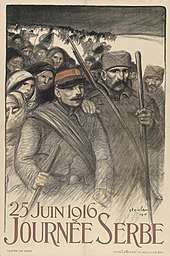
According to the official statistics from 1919, 77,455 Serbian soldiers died, while 77,278 went missing. The worst fate befell the Southern Column, where approximately 43,000 young boys that would have become conscripts in 1916 had been taken by the Army to join the retreat; within a month approximately 36,000 of them died.[43]
Of the estimated 220,000 civilian refugees who had set off for the Adriatic coast from Kosovo, only about 60,000 survived. Those who survived were so weak that thousands of them died from sheer exhaustion in the weeks after their rescue. Because the rock composition of the island made it hard to dig graves, those who died on the journey were buried at sea. Bodies were lowered from French ships into the depths of the Ionian Sea, near the Greek island of Vido; more than 5,000 Serbs are believed to have been buried this way. The sea around Vido is known as "The Blue Graveyard" (Plava Grobnica)"[44] Field Marshal Putnik traveled to France for medical treatment, where he died the following year.[45]
Serbia was divided into Austro-Hungarian and Bulgarian military occupation zones. In the Austrian zone of occupation (northern and central Serbia), a governor-general was established with a center in Belgrade. In the territory occupied by the Bulgarians, a governor-general was established with a center in Niš. Both the Austrian and the Bulgarian occupation regimes were very harsh, the population was exposed to various measures of repression, including mass internment, forced labor, concentration camps for political opponents, starvation, and Bulgarisation policy. Kosovo was divided between the Austrians and the Bulgarians - the Bulgarian army occupied the eastern regions, while the Austro-Hungarian occupied the western regions.[46]
During 1916, more than 110,000 Serbian troops were transferred to Salonika, where they joined the Allied army after Greece entered the war; some six Serbian infantry divisions and one cavalry division, named after regions and rivers in their homeland would eventually return to serve, playing a key role in the breakthrough of the Macedonian Front in September 1917, and the liberation of their homeland a year later.[47]
The retreat of the Serbian Army across Albania is considered by Serbs to be one of the greatest tragedies in their nation's history.[7]
Images
- The Great Retreat
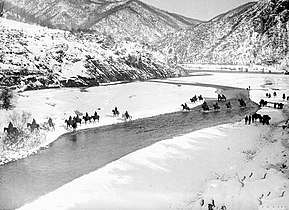 Serbian cavalry crossing the Black Drin
Serbian cavalry crossing the Black Drin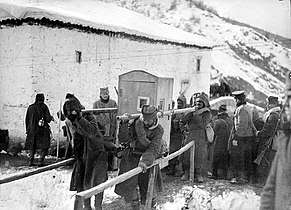 Field Marshal Radomir Putnik being carried by bearers
Field Marshal Radomir Putnik being carried by bearers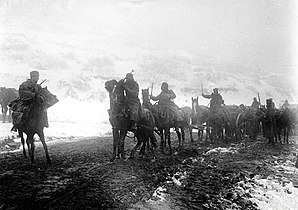 Serbian artillery during the retreat
Serbian artillery during the retreat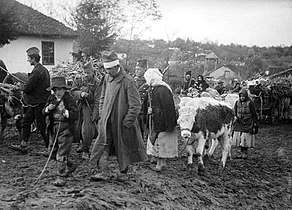 Serbian troops and refugees during the retreat
Serbian troops and refugees during the retreat The Column of the First Serbian-English Field Hospital
The Column of the First Serbian-English Field Hospital A column of Serbian soldiers
A column of Serbian soldiers Evacuation of the Serbian army
Evacuation of the Serbian army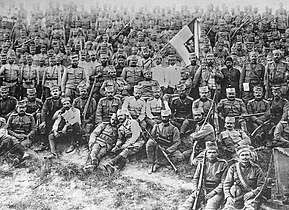 Serbian troops in Corfu, Feb 1916
Serbian troops in Corfu, Feb 1916
See also
- Commemorative Medal of the Great Serbian Retreat
- Gde Cveta Limun Žut, (2006). A documentary film about the Serbian army's retreat.
- King Peter of Serbia, (2018). A feature film starring Lazar Ristovski.
- Kreće se lađa francuska, A World War I song composed by Branislav Milosavljević in Corfu.
- Tamo Daleko, A World War I song composed in Corfu.
References
Citations
- Reader's Digest, 2000
- Hart 2015, p 189
- Dinardo 2015, p. 122
- Holger Afflerbach 2015, p. 120.
- Hall 2014, p. 280
- Motes 1999, p. 14.
- Gordon-Smith 1920, p.1
- van Ypersele, p. 287
- Schindler 2015, p. 561
- War in History, p. 159-195
- hall 2014, p 162
- Dinardo 2015, p. 110
- Buttar 2015, p.341
- Sanders 2016, p. 248
- Glenny 2012, p.334
- Richard C. Hall 2010, p. 46.
- Dinardo 2015, p. 19
- Dinardo 2015, p. 115
- Pearson 2004, p. 93
- Vickers 1999, p. 88
- RTS 2016
- Dinardo 2015, p. 106
- Sanders 2016, p. 247
- Stobart 1916, p. 243
- Dinardo 2015, p. 116
- Mitrović 2007, p. 161
- Hall 2010, p. 46
- Hall 2010, p. 280
- Ramet 2006, p. 48
- Tim Judah 2008, p. 100.
- Tallon 2014, p. 450.
- Majstorovic 2014, p. 178.
- Mojzes 2011, p. 198.
- Mojzes 2011, p. 198.
- Pavlović 2014, p. 163
- Holger Afflerbach 2015, p. 89.
- Hall 2010, p. 280
- Pearson 2004, p. 94
- Thomas, Babac 2012, p. 95
- Gordon-Smith 1920, p. 195
- Pearson 2004, p. 95
- Alan Kramer 2008, p. 142.
- Reader's Digest, 2000
- Askew 1916, p. 360
- Buttar 2015, p.
- Misha Glenny 2012, p. 333.
- Hart 2015, p 189
Bibliography
- Alice Askew; Claude Arthur Cary Askew (1916). The Stricken Land: Serbia as We Saw it. E. Nash. p. 360.
- Prit Buttar (20 August 2015). Germany Ascendant: The Eastern Front 1915. Bloomsbury Publishing. ISBN 978-1-4728-1355-8.
- Marie-Janine Calic (2019). A History of Yugoslavia. Purdue University Press. ISBN 978-1-55753-838-3.CS1 maint: ref=harv (link)
- Dinardo, Richard L. (2015). Invasion: The Conquest of Serbia, 1915. Santa Barbara: Praeger. ISBN 9781440800924.
- Misha Glenny (5 September 2012). The Balkans: Nationalism, War, and the Great Powers, 1804-2012: New and Updated. House of Anansi Press Incorporated. ISBN 978-1-77089-274-3.
- Gordon-Smith (1920). The Retreat of the Serbian Army. A Monthly Magazine of the New York Times. Vol. XI. p. 1.
- Gordon Gordon-Smith (1920). From Serbia to Jugoslavia: Serbia's Victories, Reverses and Final Triumph, 1914-1918. G.P. Putnam's Sons. p. 195.
- Richard C. Hall (2010). Balkan Breakthrough: The Battle of Dobro Pole 1918. Indiana University Press. ISBN 978-0-253-00411-6.CS1 maint: ref=harv (link)
- Richard C. Hall (2014). War in the Balkans: An Encyclopedic History from the Fall of the Ottoman Empire to the Breakup of Yugoslavia. ABC-CLIO. ISBN 978-1-61069-031-7.</ref>
- Peter Hart (14 April 2015). The Great War: A Combat History of the First World War. Oxford University Press. pp. 189–. ISBN 978-0-19-022735-7.
- Holger Afflerbach (2015). The Purpose of the First World War: War Aims and Military Strategies. Walter de Gruyter GmbH & Co KG. ISBN 978-3-11-044348-6.CS1 maint: ref=harv (link)
- Tim Judah (2008). The Serbs: History, Myth and the Destruction of Yugoslavia. Yale University Press. ISBN 978-0-300-14784-1.CS1 maint: ref=harv (link)
- Alan Kramer (2008). Dynamic of Destruction: Culture and Mass Killing in the First World War. OUP Oxford. ISBN 978-0-19-158011-6.CS1 maint: ref=harv (link)
- Majstorovic, Steven (2014). "Autonomy of the Sacred: The Endgame in Kosovo". In Máiz, Ramón; William, Safran (eds.). Identity and Territorial Autonomy in Plural Societies. Routledge. ISBN 9781135303945.CS1 maint: ref=harv (link)
- Andrej Mitrović (2007). Serbia's Great War, 1914-1918. Purdue University Press. ISBN 978-1-55753-476-7.
- Mojzes, Paul (2011). Balkan Genocides: Holocaust and Ethnic Cleansing in the Twentieth Century. Rowman & Littlefield. ISBN 978-1-4422-0663-2.CS1 maint: ref=harv (link)
- Motes, Mary (1999). Kosova, Kosovo: Prelude to War 1966-1999. Redland Press. ISBN 978-0-85036-492-7.
- Vojislav G. Pavlović (1 January 2014). Italy's Balkan Strategies (19th-20th Century). Balkanološki institut SANU. ISBN 978-86-7179-082-6.
- Owen Pearson (2004). Albania and King Zog: Independence, Republic and Monarchy, 1908-1939. I.B.Tauris. pp. 93–. ISBN 978-1-84511-013-0.
- Ramet, Sabrina P. (2006). The Three Yugoslavias: State-building and Legitimation, 1918-2005. Indiana University Press. ISBN 9780253346568.CS1 maint: ref=harv (link)
- Reader's Digest Association (2000). The War to End Wars, 1914-18. Reader's Digest. ISBN 978-0-7621-0288-4.
- Sanders Marble (2016). King of Battle: Artillery in World War I. History of Warfare. Brill Academic Publishers. ISBN 978-90-04-30728-5.
- John R. Schindler (December 2015). Fall of the Double Eagle: The Battle for Galicia and the Demise of Austria-Hungary. U of Nebraska Press. ISBN 978-1-61234-804-9.</ref>
- Mabel Annie Stobart (1916). The Flaming Sword in Serbia and Elsewhere. Hodder and Stoughton.
- Tallon, James N. (2014). "Albania's Long World War I, 1912–1925". Studia Historyczne. 4.CS1 maint: ref=harv (link)
- Nigel Thomas; Dusan Babac (20 May 2012). Armies in the Balkans 1914–18. Bloomsbury Publishing. pp. 12–. ISBN 978-1-78096-735-6.
- Miranda Vickers (1999). The Albanians: A Modern History. I.B.Tauris. ISBN 978-1-86064-541-9.
Further reading
- Jakovljević, Stevan J., 1890-1962. (2003). Srpska trilogija (Serbian trilogy) (in Serbian). Istoćnik. ISBN 86-83487-18-0. OCLC 78922797.CS1 maint: multiple names: authors list (link)
- Petrović, Rastko (1961). Dan šesti (The Sixth Day). Nolit Bgd. (in Serbian). ASIN B0089W0WZ4.
- Bojic, Milutin (2016). Plava grobnica (or Ode to a Blue Tomb) (in Serbian). ISBN 978-8651511595.
- Geert Buelens (16 February 2016). Everything to Nothing: The Poetry of the Great War, Revolution and the Transformation of Europe. Verso Books. pp. 139–. ISBN 978-1-78478-150-7.
- James Lyon (30 July 2015). Serbia and the Balkan Front, 1914: The Outbreak of the Great War. Bloomsbury Publishing. ISBN 978-1-4725-8005-4.
- Stevan K. Pavlowitch (2014). A History of the Balkans 1804-1945. Routledge. ISBN 978-1-317-90017-7.
External Links
- Zarić, Sladjana (2016). "From Serbia to Corfu, the path of the Albanian Golgotha". www.rts.rs (in Serbian).
- Life in occupied Serbia 1915 – 1918, Magazine ″Defense″, special edition No 135, Miljan Milkich, December 15, 2015. (Serbian)
- Golgotha of Serbian Army, Magazine ″Defense″, special edition No 136, Snezana Nikolich, January 1, 2016. (Serbian)
- In the bosom of Bizerte, Magazine ″Defense″, special edition No 138, Snezana Nikolich, February 15, 2016. (Serbian)
- Corfu – Island of Solvation, Magazine ″Defense″, special edition No 148, Milan Milkic, July 15, 2016. (Serbian)